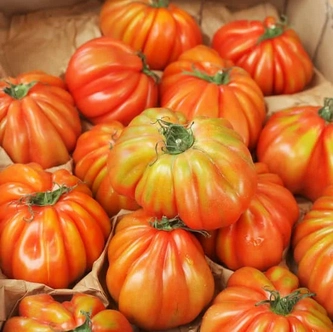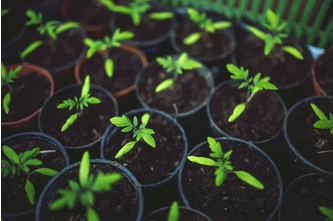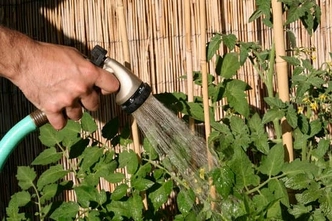A Guide to Growing Big Boy Tomatoes: Discovering Ideal Soil and Climate

-
Introduction:
- Understanding the Ideal Soil for Big Boy Tomatoes
- Factors to Consider When Choosing the Right Climate for Big Boy Tomatoes
- Preparing the Soil for Planting Big Boy Tomatoes
- Planting and Caring for Big Boy Tomato Seedlings
- Watering and Fertilizing Techniques for Big Boy Tomatoes
- Controlling Pests and Diseases in Big Boy Tomato Plants
- Pruning and Supporting Big Boy Tomato Plants
- Harvesting and Storing Big Boy Tomatoes
- Conclusion: Tips for Successful Big Boy Tomato Cultivation
- Recent Featured Articles:
Introduction:
You've come to the right place if you dream of juicy, flavorful tomatoes as big as your palm. Welcome to the ultimate guide on growing Big Boy tomatoes, where we'll uncover the secrets to achieving the ideal soil and climate to help your tomatoes thrive.
This article will explore the key factors contributing to successful tomato growth, from choosing the perfect soil composition to understanding the optimal climate conditions. Whether you're a seasoned gardener or a beginner looking to embark on your first tomato-growing adventure, this guide will provide the knowledge and insights to grow healthy, robust Big Boy tomatoes.
By the end of this read, you'll be equipped with the tools and know-how to create the ideal environment for your tomato plants, maximize their growth potential, and ensure a bountiful harvest. So grab your gardening gloves and start this flavorful journey together.
Understanding the Ideal Soil for Big Boy Tomatoes
Understanding the ideal soil conditions is paramount to successfully cultivating Big Boy tomatoes. These tomatoes thrive in nutrient-rich, well-draining soils that provide the essential elements for growth. The perfect soil blend typically combines loam, sand, and organic matter, enhancing drainage and retaining moisture and nutrients. A loamy texture is particularly beneficial, as it balances the air, water, and nutrient retention capabilities, allowing roots to expand freely and access essential resources.
The soil's pH level is another critical factor influencing Big Boy tomatoes' growth. Ideally, the soil should have a pH between 6.0 and 6.8. This slightly acidic range optimizes nutrient availability, promoting healthy plant growth. Testing the soil pH is straightforward, and if adjustments are necessary, they can be made using lime to raise the pH or sulfur to lower it. Regular monitoring of soil composition ensures that your tomato plants have the best possible environment to thrive.
In addition to pH, the soil should be rich in organic matter. Incorporating compost or well-rotted manure into the soil enriches it with nutrients and improves its structure. Organic matter enhances microbial activity, essential for separating nutrients into forms that plants can absorb. This nutrient-rich environment is crucial for the robust growth of Big Boy tomatoes, helping them reach their potential size and flavor.
Factors to Consider When Choosing the Right Climate for Big Boy Tomatoes
The climate in which you grow Big Boy tomatoes can significantly impact their growth and yield. These tomatoes flourish in warm climates with plenty of sunshine, requiring a minimum of six to eight hours of direct sunlight daily. Ideal temperatures for growth range from 70°F to 85°F during the day. Temperatures below 55°F can stunt growth and affect fruit development, while extreme heat above 90°F may lead to blossom drop and reduced fruit set.
Humidity levels also play a crucial role in tomato cultivation. Big Boy tomatoes appreciate moderate humidity, generally around 40-70%. Too much humidity can lead to diseases like blight, while low humidity can cause the plants to become stressed, potentially affecting their fruit production. Monitoring weather patterns and adjusting your watering and care practices can help maintain an ideal growing environment.
Another factor to consider is the length of the growing season. Big Boy tomatoes typically require a growing season of 70 to 80 days from transplanting to harvest. Starting seeds indoors or using protective measures like row covers can extend the growing period in regions with shorter growing seasons. Understanding your local climate and making necessary adjustments will ensure that your tomatoes have the best chance for a successful and abundant harvest.
Preparing the Soil for Planting Big Boy Tomatoes
Proper soil preparation promotes healthy growth before planting Big Boy tomatoes. Start by testing your soil to determine its nutrient content and pH level. You can amend the soil to create the ideal growing conditions based on the results. Adding organic matter such as compost or peat moss enriches the soil with nutrients and enhances its structure, making it easier for roots to penetrate and grow.
Next, it's important to loosen the soil to a depth of at least 12 inches. This can be achieved using a garden fork or rototiller, breaking up compacted soil to improve aeration and drainage. Once the soil is loose, incorporate your organic amendments evenly throughout the planting area. This step is crucial, as it leads to a well-mixed environment where nutrients are readily available to the plants.
Finally, level the soil and create raised beds if necessary. Raised beds can improve drainage and ensure that the soil warms up faster in the spring, which is beneficial for early planting. After leveling the soil, consider applying a pre-plant fertilizer high in phosphorus to promote strong root development. These preparation steps will set the stage for your Big Boy tomatoes to thrive once planted.
Optimal Soil for Raised Vegetable Garden Beds
Planting and Caring for Big Boy Tomato Seedlings
Once your soil is prepared, it's time to plant your Big Boy tomato seedlings. Ideally, transplant seedlings when they are about 6 to 8 inches tall and have at least two sets of true leaves. This usually occurs 6 to 8 weeks after starting seeds indoors. When planting, space the seedlings 24 to 36 inches apart to allow for ample growth and airflow, which helps prevent disease.
When placing the seedlings in the ground, bury them deep enough so the lower leaves are just above the soil surface. Tomatoes can develop roots along their stems, so planting them deeper encourages a stronger root system. Water the seedlings thoroughly after planting to help settle the soil around their roots and reduce transplant shock. This initial watering is crucial for establishing a healthy plant.
Caring for Big Boy tomato seedlings involves regular monitoring and maintenance. Ensure they receive adequate sunlight and protection from extreme weather. If nighttime temperatures are expected to drop, consider using row covers or cloches to shield them. Additionally, staking or caging young plants early on will support their growth and prevent sprawling, which can lead to disease and reduced fruit production. Consistent care during this crucial time sets the foundation for a productive tomato crop.
Watering and Fertilizing Techniques for Big Boy Tomatoes
Watering is one of the most vital aspects of growing Big Boy tomatoes. These plants require consistent moisture to thrive, particularly during fruit development. Watering deeply and infrequently rather than applying light is essential. Aiming for about 1 to 1.5 inches of water per week is ideal, and this can be adjusted based on rainfall and temperature. Using drip irrigation or soaker hoses can help deliver water directly to the roots while minimizing water loss and keeping foliage dry.
In addition to proper watering techniques, fertilization is crucial in promoting healthy growth and fruit production. After planting, it's advisable to apply a balanced fertilizer with a higher phosphorus content to support root development.
Once the plants begin to flower, switch to a fertilizer higher in potassium to enhance fruit growth and flavor. Organic options like fish emulsion or kelp extract can also provide essential nutrients without the risk of chemical build-up in the soil.
It is important to monitor the plants for signs of nutrient deficiencies. Yellowing leaves, stunted growth, or poor fruit set can indicate a lack of essential nutrients. In such cases, conducting soil tests can help pinpoint specific deficiencies. Adjusting your fertilization routine based on these observations will help ensure that your Big Boy tomatoes receive the nutrients they need for robust growth and maximum yield.
Controlling Pests and Diseases in Big Boy Tomato Plants
Pest and disease management is critical for maintaining the health of your Big Boy tomato plants. Common pests that affect tomatoes include aphids, spider mites, and whiteflies. Regularly inspecting plants for signs of infestation allows for early intervention. Introducing beneficial insects, such as ladybugs and lacewings, can help control pest populations naturally. For heavier infestations, insecticidal soaps or neem oil can be effective without harming beneficial insects.
Disease prevention is equally important. Common tomato diseases include blight, wilt, and powdery mildew. To minimize the risk of these diseases, practice crop rotation, avoiding planting tomatoes in the same location year after year.
Additionally, ensure proper spacing between plants to improve airflow and reduce humidity around foliage. Mulching around the base of plants can also help prevent soil-borne diseases from splashing onto leaves during watering or rain.
Regularly maintaining your garden and removing any diseased plants or debris will also help prevent the spread of disease. Keeping a close eye on the condition of your plants will allow you to spot issues early and take appropriate action. By employing these integrated pest management strategies, you can protect your Big Boy tomatoes and ensure a healthy, productive harvest.
Pruning and Supporting Big Boy Tomato Plants
Pruning is essential for maximizing Big Boy tomatoes' yield and quality. Regularly removing suckers or the small shoots that develop in the leaf axils allows the plant to focus its energy on producing fruit. Pruning should be done carefully, ensuring you do not remove too many leaves, which is vital for photosynthesis. Aim to prune once weekly during the growing season to manage plant size and promote better airflow.
In addition to pruning, providing physical support for your Big Boy tomato plants is crucial. Using stakes, cages, or trellises helps keep the plants upright, preventing sprawling and reducing disease risk. Tomato cages are particularly effective, allowing for easy plant access while providing ample support as they grow. When using stakes, inserting them when planting is important to avoid damaging the roots later on.
Supporting and pruning your tomato plants enhances their growth and simplifies harvesting. With well-supported plants, the fruits are less likely to touch the ground, reducing the risk of rot and disease. As you care for your Big Boy tomatoes, remember that regular attention to pruning and support will lead to healthier plants and a more bountiful harvest.
Harvesting and Storing Big Boy Tomatoes
Harvesting Big Boy tomatoes at the right time is crucial for achieving optimal flavor and texture. These tomatoes should be picked when they reach a deep red color and are slightly firm to the touch. The best time to harvest is early in the morning when temperatures are cooler, which helps preserve the freshness of the fruit. Gently twist the fruit off the vine, or use garden scissors to avoid damaging the plant.
If you still have green tomatoes but anticipate a temperature drop, you can harvest them and allow them to ripen indoors. Place them in a paper bag with a banana or apple, as the ethylene gas produced by these fruits can speed up the ripening process. However, for the best flavor, it's recommended to let them ripen on the vine whenever possible.
Proper storage is essential for maintaining the quality of your harvested Big Boy tomatoes. Store them at room temperature away from direct sunlight, as refrigeration can alter their flavor and texture. If you have an abundance of tomatoes, consider canning or preserving them to enjoy their taste throughout the year. Dried or canned tomatoes can add a delicious touch to various dishes, allowing you to savor your hard work long after the growing season.
Conclusion: Tips for Successful Big Boy Tomato Cultivation
Successfully growing Big Boy tomatoes requires attention to detail and a commitment to understanding their needs. Start with high-quality seeds or seedlings and ensure they are planted in well-prepared soil with the right nutrients.
Pay close attention to the climate and environmental conditions, adjusting your care practices to accommodate weather changes.
Regular maintenance, including proper watering, fertilizing, and pest control, will contribute to a healthy growing environment. Pruning and supporting your plants will improve air circulation and maximize fruit production. Finally, harvest your tomatoes at just the right moment for the best flavor and consider methods for preserving your bounty for later enjoyment.
With these tips in mind, you'll be well on your way to cultivating a thriving crop of Big Boy tomatoes. Enjoy the gardening journey, and with patience and dedication, you'll be rewarded with delicious, homegrown tomatoes that will impress you. Happy gardening!
Recent Featured Articles:
"Growing Gold: Unveiling the Magic of 50 Better Boy Tomato Seeds"
Grow Juicy Big Zac Tomatoes at Home!
The Ultimate Guide to Growing and Caring for Early Girl Tomatoes
-
Introduction:
- Understanding the Ideal Soil for Big Boy Tomatoes
- Factors to Consider When Choosing the Right Climate for Big Boy Tomatoes
- Preparing the Soil for Planting Big Boy Tomatoes
- Planting and Caring for Big Boy Tomato Seedlings
- Watering and Fertilizing Techniques for Big Boy Tomatoes
- Controlling Pests and Diseases in Big Boy Tomato Plants
- Pruning and Supporting Big Boy Tomato Plants
- Harvesting and Storing Big Boy Tomatoes
- Conclusion: Tips for Successful Big Boy Tomato Cultivation
- Recent Featured Articles:



